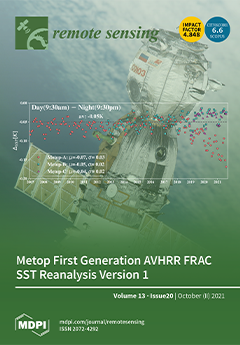Ocean surface net radiation (R
n) is significant in research on the Earth’s heat balance systems, air–sea interactions, and other applications. However, there have been few studies on R
n until now. Based on radiative and meteorological measurements collected from 66 globally
[...] Read more.
Ocean surface net radiation (R
n) is significant in research on the Earth’s heat balance systems, air–sea interactions, and other applications. However, there have been few studies on R
n until now. Based on radiative and meteorological measurements collected from 66 globally distributed moored buoys, it was found that R
n was dominated by downward shortwave radiation (
) when the length ratio of daytime (LRD) was greater than 0.4 but dominated by downward longwave radiation (
) for the other cases (LRD ≤ 0.4). Therefore, an empirical scheme that includes two conditional models named Case 1 (LRD > 0.4) utilizing
as a major input and Case 2 (LRD ≤ 0.4) utilizing
as a major input for R
n estimation was successfully developed. After validation against in situ R
n, the performance of the empirical scheme was satisfactory with an overall R
2 value of 0.972, an RMSE of 9.768 Wm
−2, and a bias of −0.092 Wm
−2. Specifically, the accuracies of the two conditional models were also very good, with RMSEs of 9.805 and 2.824 Wm
−2 and biases of −0.095 and 0.346 Wm
−2 for the Case 1 and Case 2 models, respectively. However, due to the limited number of available samples, the performances of these new models were poor in coastal and high-latitude areas, and the models did not work when the LRD was too small (i.e., LRD < 0.3). Overall, the newly developed empirical scheme for R
n estimation has strong potential to be widely used in practical use because of its simple format and high accuracy.
Full article





